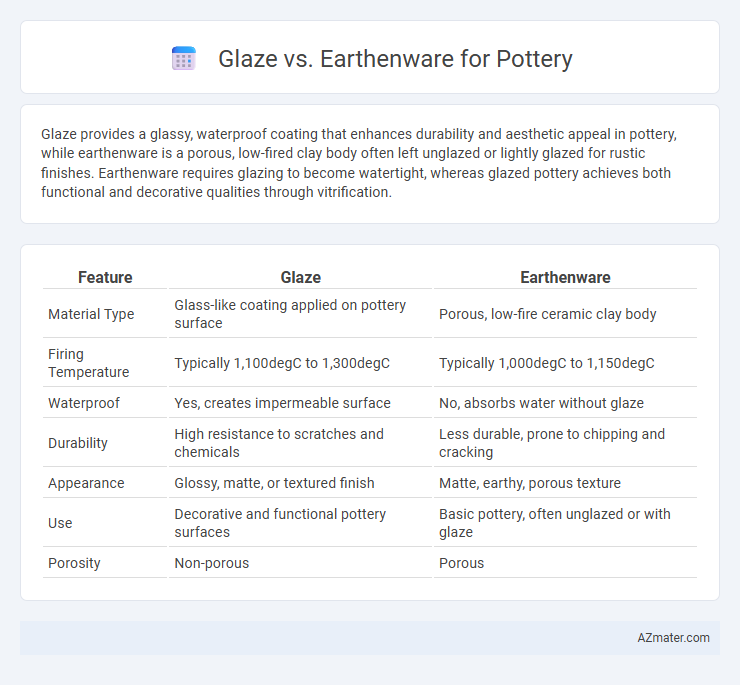Glaze provides a glassy, waterproof coating that enhances durability and aesthetic appeal in pottery, while earthenware is a porous, low-fired clay body often left unglazed or lightly glazed for rustic finishes. Earthenware requires glazing to become watertight, whereas glazed pottery achieves both functional and decorative qualities through vitrification.
Table of Comparison
| Feature | Glaze | Earthenware |
|---|---|---|
| Material Type | Glass-like coating applied on pottery surface | Porous, low-fire ceramic clay body |
| Firing Temperature | Typically 1,100degC to 1,300degC | Typically 1,000degC to 1,150degC |
| Waterproof | Yes, creates impermeable surface | No, absorbs water without glaze |
| Durability | High resistance to scratches and chemicals | Less durable, prone to chipping and cracking |
| Appearance | Glossy, matte, or textured finish | Matte, earthy, porous texture |
| Use | Decorative and functional pottery surfaces | Basic pottery, often unglazed or with glaze |
| Porosity | Non-porous | Porous |
Introduction to Pottery Finishes: Glaze vs Earthenware
Glaze and earthenware represent foundational pottery finishes with distinct characteristics and purposes. Glaze is a glassy coating fused to pottery surfaces, offering waterproofing, durability, and vibrant aesthetics, while earthenware refers to low-fired clay with a porous texture, often left unglazed or minimally finished. Understanding the differences between these finishes is essential for selecting the right technique based on functional requirements and artistic intent in ceramic art.
What is Glazed Pottery?
Glazed pottery features a glassy, often colorful coating applied to earthenware that enhances its durability and waterproof qualities. This vitreous layer seals the porous surface of earthenware, preventing water absorption and making the pottery suitable for functional uses like holding liquids or food. The glaze also adds decorative appeal through various textures, colors, and finishes, distinguishing glazed pottery from unglazed earthenware pieces.
Defining Earthenware Pottery
Earthenware pottery is a type of ceramic fired at lower temperatures, typically between 1,000 to 1,150 degrees Celsius, resulting in a porous and less durable material compared to stoneware or porcelain. It often requires a glaze to make the surface waterproof and enhance durability, as unglazed earthenware is absorbent and fragile. The glaze not only seals the porous body but also adds color, texture, and decorative effects, making it essential for functional and aesthetic purposes in earthenware ceramics.
Material Composition: Glaze vs Earthenware
Glaze is a glassy coating fused to the surface of pottery, composed mainly of silica, fluxes, and alumina, which melts and forms a smooth, impermeable layer during firing, enhancing both aesthetic appeal and durability. Earthenware clay consists primarily of natural minerals like kaolinite, quartz, and iron oxides, fired at lower temperatures, resulting in a porous, softer body that requires glazing for waterproofing and strength. The fundamental difference lies in earthenware being the actual ceramic material, while glaze serves as a protective and decorative surface treatment.
Surface Texture and Appearance Comparison
Glaze creates a smooth, glossy surface on pottery that enhances color vibrancy and provides a waterproof finish, while earthenware typically has a more porous, matte texture that absorbs liquids and displays natural, earthy tones. Glazed pottery often exhibits a reflective sheen with a range of finishes from satin to high gloss, whereas earthenware surfaces are characterized by their rougher, tactile quality and rustic appearance. The choice between glaze and earthenware significantly affects durability and the visual impact of the ceramic piece.
Durability and Functionality Differences
Glaze significantly enhances earthenware's durability by creating a glass-like surface that resists water absorption, stains, and scratches, making it suitable for functional pottery such as dinnerware and storage containers. Unglazed earthenware remains porous and fragile, limiting its use to decorative or dry storage items due to its susceptibility to chipping and moisture damage. The choice between glazed and unglazed earthenware directly impacts the pottery's longevity, maintenance requirements, and practical applications in daily use.
Water Resistance and Porosity Explained
Glaze significantly enhances the water resistance of earthenware by creating a non-porous, glass-like surface that prevents water absorption, unlike unglazed earthenware, which remains porous and prone to moisture penetration. Earthenware vessels without glaze absorb water due to their porous clay body, compromising durability and suitability for holding liquids over time. Properly glazed earthenware combines aesthetic appeal with functional water resistance, making it ideal for both decorative and practical pottery uses.
Firing Temperatures and Techniques
Glaze on pottery typically requires higher firing temperatures, ranging from 1,100degC to 1,300degC, to properly vitrify and create a smooth, glass-like surface, while earthenware is fired at lower temperatures, generally between 1,000degC and 1,150degC, resulting in a more porous and less vitrified body. The glazing process involves applying a silica-based coating that melts and fuses to the surface during firing, enhancing durability and aesthetics, whereas earthenware is often left unglazed or coated with slips for decorative purposes. Techniques for firing glazed pottery usually include controlled oxidation or reduction atmospheres in gas or electric kilns, whereas earthenware is commonly fired in oxidation atmospheres in either electric kilns or traditional wood firings.
Best Uses for Glaze and Earthenware Pottery
Glaze enhances earthenware pottery by providing a waterproof, durable surface ideal for functional items like dinnerware and plant pots. Earthenware's porous nature makes it perfect for decorative pieces, garden pots, and low-fire ceramics that benefit from its natural, rustic texture. Combining glaze with earthenware expands usability by adding color, shine, and protection while maintaining the pottery's traditional aesthetic appeal.
Choosing the Right Finish: Glaze or Earthenware?
Choosing the right finish for pottery involves understanding the differences between glaze and earthenware; glaze provides a glass-like, waterproof surface ideal for functional pieces, while earthenware offers a porous, matte finish suited for decorative art. Glazed pottery resists stains and is easier to clean, making it perfect for tableware, whereas earthenware's natural texture enhances rustic aesthetics and breathability. Selecting between glaze and earthenware depends on the intended use, desired durability, and visual effect of the final piece.

Infographic: Glaze vs Earthenware for Pottery
 azmater.com
azmater.com